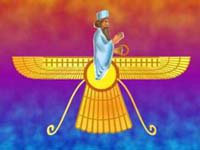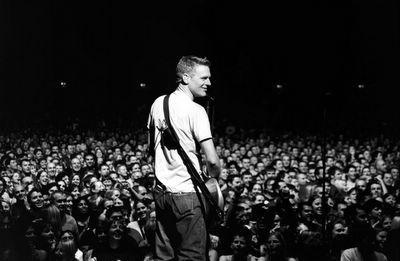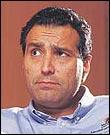
Well, the recently concluded, fiercly competed Ashes Tournament prompted me to write on it's history popularity and charm. Move over thoes guys who say India Pakistan cricket is the most fiercly competed cricket in the world. In the recently concluded Pakistan's tour of India, you could see that the indians were exhausted even before the one dayers started.
Well, England the underdogs before the ashes begun eventually went on to win the fabled urn. Each match was nail bitting and literally went to the last ball. How often do u see such a close test cricket tournament. It was a historic tournament in the fact that England won it after 16 years and also that it was Shane Warne, and Glen McGrath's last ashes.
Ashes: The History:- In October 1861, an English representative cricket team captained by Heathfield Stephenson, set sail from Liverpool in England with the purpose of visiting Australia and engaging the "local" colonial population in a number of cricket matches. On arrival in Australia in March 1862, the English team was amazed by the greeting they received from thousands of people present when the ship berthed in Melbourne. More to their amazement was the fact, the streets of Melbourne were lined by many thousands more people who had come out to greet the visiting team.
Although cricket had already been well established in Australia for many years, the Englishmen could not believe the level of support for the game in Australia. Rather than treated as simple sportsmen, they were accorded a level of status usually reserved for the most important VIP's and royalty. It appeared to the Englishmen, the sport was as popular in Australia as it was in the mother country.
During their tour of Australia, the English team played a total of 14 matches against a variety of teams representing the colonies of Victoria and New South Wales. Australia at this time, was made up of a number of separate colonies and as such, did not have a National team for cricket, therefore at no stage did the Englishmen have the opportunity to take on the best the Aussies could muster. What is very notable about the tour however, is the fact the Englishmen competed against a team in Melbourne, representing The World. From the 14 matches played, it became very evident to the touring team, Australia was not to be taken lightly when it came to the sport of cricket. A total of 5 draws and 3 losses were inflicted upon the tourists, who had at no stage conceived any idea the Australians may be capable of offering any decent competition.
The annual competition between England and Australia continued for several years to come. On 5th March 1877, a touring English team met the Australian team in the very first Test match in Melbourne. This match was a ferociously competitive game with the Australians coming out on top and winning by the margin of 45 runs. The English were not happy with this situation as they had put together the finest team of professional cricketers money could buy at the time. They found it difficult to accept they had been beaten in the very first test match, by a team from the colonies that consisted mainly of part-time cricketers.
The BirthGreat rivalry began to develop between the Australian and English teams, setting the scene for future battles between the two, and attempts by the English to dominate the sport they had developed. They were seriously concerned the sport of gentlemen was being dominated by the convicts from the Antipodes and the thinking of the day became, England must win at all costs.
The greatest cricket competition in history was about to begin. The Ashes were close to being born!
England's RevengeThere was nothing unusual about the Australian tour to England in the summer of 1882, other than the fact, only one Test match was scheduled to be played at The Oval on 28 August. In the lead up to the Test match at The Oval, Australia had won 4 out of the seven matches they had already played, needless to say, the English were looking to atone for these losses and embarrass the Australians by giving them a lesson in cricket they would never forget. England carefully chose the best possible team in order to inflict the "demanded" defeat on the Australians.
At the beginning of the match on the 28th August, Australian captain W Murdoch, having won the toss, decided the Aussies would bat first. The English bowlers decimated the batting line-up and Australia returned the paltry figures of all out for 63 runs. The Englishmen were quite amused by this small first innings total and believed they would more than eclipse such a minor score. The amusement was promptly wiped from their faces by the Australians and even though the English team managed a first innings lead of 38 runs, the total for the innings was only 101 runs.
The Aussies although feeling confident, believed the Englishmen would bounce back in their second innings and as a result, Australia would need to post a very healthy second innings lead to have any real hope of an outright win. Unfortunately luck was not on the side of the Australians, they returned another small score at the end of their second innings when they were all out for 122 runs. This left England needing only 85 runs to take victory in the match, it appeared a foregone conclusion and the Aussies were somewhat dejected with the situation.
By the time England had reached the score of 4 for 65, it appeared there was no hope of an Australian victory, how wrong the thinking was!. At one stage with 5 wickets remaining, England required only 19 runs to take the match. Events were about to overcome everyone who was at The Oval on this day. Fred Spofforth an Australian bowler who had already taken several wickets for the innings was brought back into the bowling attack and subsequently tore the English batsmen to pieces with the assistance of Henry Boyle. The English team collapsed to be all out for 77 runs leaving them short of victory by just 8 runs. The unthinkable had happened, the English had been beaten from an unassailable position, the Australians had triumphed even though the odds were against them.
Everyone at The Oval for the match could not believe what had happened, not only were the crowds in shock at the defeat, many of the players could not believe what had just transpired and were left stunned and speechless. The following day, the British press ferociously savaged the performance of the England team, they called the performance of the team "the worst in living memory". The most notable of the English press at the time, a newspaper called the Sporting Times printed an obituary to cricket which read.
" In Affectionate Remembrance of English Cricket Which Died At The Oval on29th August 1882. Deeply lamented by a large circle of sorrowing friends and acquaintancesR.I.P NB: The body will be cremated, and the ashes taken to Australia."
Needless to say, after the debacle that became known as The Ashes test in 1882, the English cricket authorities were adamant that never again would the English team suffer such a humiliating defeat. A tour of Australia was promptly planned for the latter part of 1882, early 1883 and to ensure England had a more than even chance of making amends for their embarrassing defeat at the hands of the Aussies, three tests were scheduled to be played. The English cricket authorities figured they would indeed be able to defeat the opposition in a best of three series.
After a meeting at Lord's of the English cricket authorities, it was decided to appoint the Honorable Francis Bligh as captain for the forthcoming tour. Bligh was ordered by the Lord's members to make sure the Ashes of cricket were returned to their rightful home in England. A team of English cricketers were put together with the aim of regaining the glory of English cricket. They promptly departed England arriving in Australia in November 1882. After many preliminary games against various teams from the colonies, the first test in December 1882 turned out to be a nightmare for the visiting English team. Beaten comprehensively by the Aussies by the winning margin of 9 wickets, it appeared any hope of regaining The Ashes might be an up-hill battle.
Instructions were issued to the English players, they must win at all costs in the second test at Melbourne. With the reputation of English cricket on the line and faced with the embarrassment of having to return home a defeated team, the Englishman rose to the occasion in the second test. Not only did they defeat the Aussies, they won by the huge winning margin of an innings and 27 runs. It appeared after all, the reputation of English cricket could and would be salvaged. With the series now tied, huge crowds were expected for the third and deciding test scheduled for February 1883 in Sydney.
The third test was a ferocious affair, the Aussies threw everything they had at the England team, however they could not manage to win the match, England were victorious by the margin of 69 runs. The Englishmen had won the series 2-1, and in the process re-instated the pride and reputation they had lost at The Oval in 1882, they could now return home the heroes.
The Ashes were to be returned to their "rightful" domain!
Velvet and AshThe English captain during his stay in Sydney for the third test was billeted at the home of the Fletcher family in the suburb of Woollahra. On his return to the Fletcher home from the after match celebrations, it was suggested by Annie Fletcher she should make a velvet bag in which Bligh could store the "imaginary" Ashes of English cricket, Bligh agreed with Annie's suggestion. Annie promptly made a beautiful brown velvet bag with the year 1883 embroidered on the front in gold thread, she presented this bag to Bligh, who accepted it with great thanks and appreciation of her efforts.
After his departure from Sydney, Bligh traveled to Melbourne where he met a lady named Florence Morphy, and after showing her the bag which he had been presented with in Sydney, Ms Morphy and several friends decided it was not a grand enough trophy for such a celebrated occasion. After purchasing a silver urn, the ladies then burnt a stump or a bail and deposited the ashes into the urn. No-one is quite sure whether it is the ashes of a stump or bail contained in the urn, the actual secret died with Ms Morphy and Bligh, who were later married on one of Bligh's further trips to Australia.
After adding a further test to the Australian tour in 1883, the triumphant English team returned home to a heroes welcome. The Ashes were presented to the English cricket authorities and then promptly presented to the members at Lord's, who later returned them to the possession of Bligh. Bligh took the Ashes with him when he traveled back to Australia and married Florence Morphy. No more was heard of the Ashes until the death of Bligh in 1927, when they were presented to the Marylebone Cricket Club, who put them on permanent display together with a pottery duplicate in a cabinet at Lord's.
Rumour has it, that at some stage during the time the Ashes were in the possession of Bligh in Australia, a servant spilt the contents of the Ashes urn onto the carpet in the home of Bligh and was unable to re-gather them. It is said the servant replaced these Ashes with those of burnt sticks, however this rumour has never been verified and remains just that, a rumour!
The only time the Ashes have left their display cabinet at Lord's was in 1988, when they were flown to Australia as part of the bicentennial celebrations. So treasured are the Ashes, they were flown by RAAF VIP aircraft and escorted to and from Lord's by a police escort.
Bodyline SeriesFrom the original match at The Oval in 1882 that gave birth to the Ashes, the competition and its players has continued to develop over the years and has stood the test of time. Many notable periods, victories and losses could be mentioned regarding the Ashes series, however the most notable moment in Ashes history came with the series known as Bodyline. No single moment or incident in cricket history has been written or talked about as much as this single cricket series. Bodyline to this day, comes into conversation amongst cricket fans, it is argued, debated, and often the cause of spilt blood. It was the single most defining moment in cricket relations with rivalry between England and Australia that went on to further strengthen the determination of an Australian team in winning an Ashes series against England.
Another notable moment in Australia v England cricket history was in 1977, when Australia and England met in the Centenary Test at the Melbourne Cricket Ground. This match was played to celebrate one hundred years of test cricket between the two opponents and just like the very first test match played in 1877, Australia was once again triumphant by the winning margin of 45 runs.
The arrival of the English touring side in Australia for the Ashes series during the summer of 1932-3 was much anticipated by all Australian cricket fans. Unknown to the Australians at the time was the fact, English captain Douglas Jardine was about to write his team into the record and history books for all the wrong reasons. To counter the skill of the great Australian player
Donald Bradman, who had devastated the English bowling attack during the 1930 series, Jardine adopted a tactic later to become known as Bodyline.
Bodyline involved the placing of a least five players close in to the batsman and the bowler continually bowling a barrage of short pitched balls aimed on leg stump, these balls would quickly rare up from the pitch placing the batsman in danger of serious injury. To counter these rising deliveries, the batsman would be forced to adopt defensive batting strokes, which would regularly result in catches to the close in fieldsmen.
Donald Bradman, being an exceptionally gifted and attacking batsman was affected by these close in fielders who interfered with his concentration. In the second test held in Melbourne, Bradman was dismissed by English bowler Bill Bowes without scoring. Many Australian players were subsequently injured as a result of the tactic of Bodyline. It was not only the Australian players who were aghast at the despicable tactics of the English, but also the Australian cricket authorities.
The Australian Cricket Board sent an urgent telegram to its counterpart in England demanding they instruct Jardine to discontinue his methods. For the sake of cricket and sportsmanship the Australians pleaded with the English to refrain. Discussions were even held in the Australian Parliament to find a way to stop the Englishmen from devastating and tarnishing the game of cricket.
High-level diplomatic meetings were held between the English and the Australians, eventually Jardine was ordered to refrain from his dangerous tactics. The Englishmen eventually went on to win back the Ashes from Australia, however the tactics of Bodyline had served their purpose. They had contained and restrained the great Donald Bradman.
The Laws of Cricket were eventually changed to ensure the debacle, which was the Bodyline series was never repeated. The spirit of the game had to be protected at all costs.
The tactic of Bodyline bowling, a name coined by the Australian press was referred to as Leg Theory by the English.
Ball of the century: The Ball of the Century, also known as the Gatting Ball or simply That Ball, was a bowled by Shane Warne to Mike Gatting on 4 June 1993, during the first Test match of the 1993 Ashes cricket series, at Old Trafford in Manchester. The leg spin Warne imparted to the ball caused it to swerve in towards Gatting in its flight through the air, and then to deviate sharply away from him on bouncing. This caught Gatting by surprise; the ball hit his wicket and thus got him out bowled, turning the balance of the match in Australia's favour. It was Warne's first ball against England in what would turn into a long and record-breaking career, and was of vast significance in the context of the match and the series.
VIEW THE CLIPhttp://media.putfile.com/Warne01/originalAshes Statistics





















